Entertaining Comics, more commonly known as EC Comics, was an American publisher of comic books, which specialized in horror fiction, crime fiction, satire, military fiction, dark fantasy, and science fiction from the 1940s through the mid-1950s, notably the Tales from the Crypt series. Initially, EC was owned by Maxwell Gaines and specialized in educational and child-oriented stories. After Max Gaines' death in a boating accident in 1947, his son William Gaines took over the company and began to print more mature stories, delving into genres of horror, war, fantasy, science-fiction, adventure, and others. Noted for their high quality and shock endings, these stories were also unique in their socially conscious, progressive themes that anticipated the Civil Rights Movement and dawn of 1960s counterculture. In 1954–55, censorship pressures prompted it to concentrate on the humor magazine Mad, leading to the company's greatest and most enduring success. Consequently, by 1956, the company ceased publishing all of its comic lines except Mad.

Gemstone Publishing is an American company that publishes comic book price guides. The company was formed by Diamond Comic Distributors President and Chief Executive Officer Steve Geppi in 1994 when he bought Overstreet.
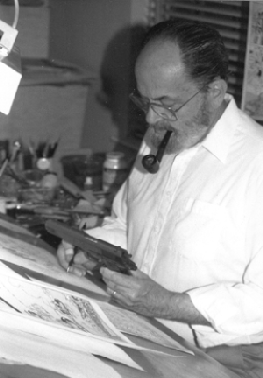
John Powers Severin was an American comics artist noted for his distinctive work with EC Comics, primarily on the war comics Two-Fisted Tales and Frontline Combat; for Marvel Comics, especially its war and Western comics; and for his 45-year stint with the satiric magazine Cracked. He was one of the founding cartoonists of Mad in 1952.

The Vault of Horror was an American bi-monthly horror comic anthology series published by EC Comics in the early 1950s. Along with Tales from the Crypt and The Haunt of Fear, it formed a trifecta of popular EC horror anthologies. The Vault of Horror hit newsstands with its April/May 1950 issue and ceased publication with its December/January 1955 issue, producing a total of 40 issues.
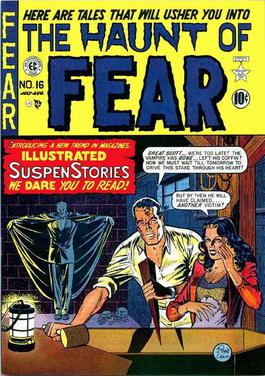
The Haunt of Fear was an American bi-monthly horror comic anthology series published by EC Comics, starting in 1950. Along with Tales from the Crypt and The Vault of Horror, it formed a trifecta of popular EC horror anthologies. The Haunt of Fear was sold at newsstands beginning with its May/June 1950 issue.
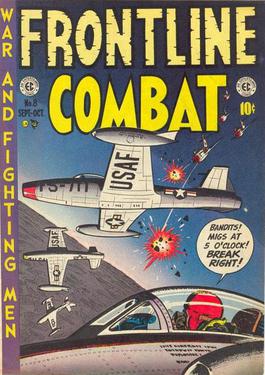
Frontline Combat is an anthology war comic book written and edited by Harvey Kurtzman and published bi-monthly by EC Comics. The first issue was cover dated July/August, 1951. It ran for 15 issues over three years, and ended with the January, 1954 issue. Publication was discontinued following a decline in sales attributed to the end of the Korean War. The title was a companion to Kurtzman's comic book Two-Fisted Tales. Both titles depicted the horrors of war realistically and in great detail, exposing what Kurtzman saw as the truth about war without glamorizing or idealizing it.

Crime SuspenStories was a bi-monthly anthology crime comic published by EC Comics in the early 1950s. The title first arrived on newsstands with its October/November 1950 issue and ceased publication with its February/March 1955 issue, producing a total of 27 issues. Years after its demise, the title was reprinted in its entirety, and four stories were adapted for television in the HBO's Tales From The Crypt.
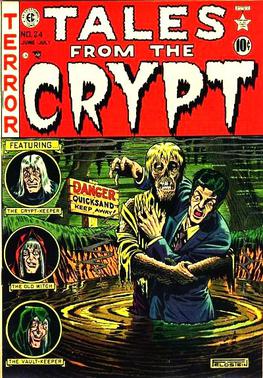
Tales from the Crypt was an American bi-monthly horror comic anthology series published by EC Comics from 1950 to 1955, producing 27 issues. Along with its sister titles, The Haunt of Fear and The Vault of Horror, Tales from the Crypt was popular, but in the late 1940s and early 1950s comic books came under attack from parents, clergymen, schoolteachers and others who believed the books contributed to illiteracy and juvenile delinquency. In April and June 1954, highly publicized congressional subcommittee hearings on the effects of comic books upon children left the industry shaken. With the subsequent imposition of a highly restrictive Comics Code, EC Comics publisher Bill Gaines cancelled Tales from the Crypt and its two companion horror titles, along with the company's remaining crime and science fiction series in September 1954.
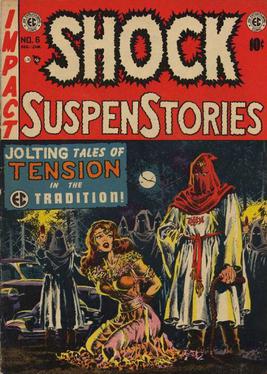
Shock SuspenStories was part of the EC Comics line in the early 1950s. The bi-monthly comic, published by Bill Gaines and edited by Al Feldstein, began with issue 1 in February/March 1952. Over a four-year span, it ran for 18 issues, ending with the December/January 1955 issue.
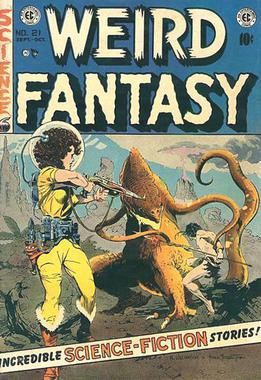
Weird Fantasy is an American dark fantasy and science fiction anthology comic that was part of the EC Comics line in the early 1950s. The companion comic for Weird Fantasy was Weird Science. Over a four-year span, Weird Fantasy ran for 22 issues, ending with the November–December 1953 issue.

Weird Science was an American science fiction comic book magazine that was part of the EC Comics line in the early 1950s. Over a four-year span, the comic ran for 22 issues, ending with the November–December, 1953 issue. Weird Fantasy was a sister title published during the same time frame.
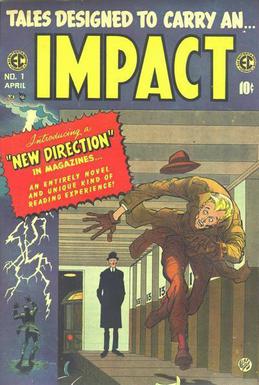
Impact was a short-lived comic book series published by EC Comics in 1955 as the first title in its New Direction line.

Jerome DeFuccio was an American comic book writer and editor known primarily for his work at Mad, where he was an associate editor for 25 years. He was also closely involved in many of the Mad paperbacks, editing Clods' Letters to Mad and many other reprints and spin-offs. Some of his contributions to EC Comics appeared under the pseudonym Jerry Dee.

Valor was a comic book published by EC Comics in 1955 as the second title in its New Direction line. The bi-monthly comic was published by Bill Gaines and edited by Al Feldstein. It lasted a total of five issues before being cancelled, along with EC's other New Direction comics.
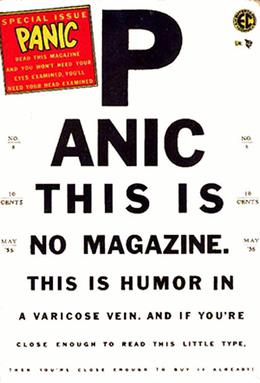
Panic was a bi-monthly humor comic that was published by Bill Gaines' EC Comics line during the mid-1950s as a companion to Harvey Kurtzman's Mad, which was being heavily imitated by other comic publishers.

The EC Archives are an ongoing series of American hardcover collections of full-color comic book reprints of EC Comics, published by Russ Cochran and Gemstone Publishing from 2006 to 2008, and then continued by Cochran and Grant Geissman's GC imprint (2011–2012), and finally taken over by Dark Horse in 2013.
Russ Cochran was a publisher of EC Comics reprints, Disney comics, and books on Hopalong Cassidy, Chet Atkins, Les Paul, and vacuum tubes. He was a publisher for over 30 years, after quitting his job as a physics professor.

Three Dimensional E.C. Classics was a quarterly comic book anthology series published by EC Comics in 1954. It began publication with its Spring 1954 issue and ceased with its March 1954 issue, producing a total of two issues. The stories it contained were classics in that they were recyclings of stories that had already appeared in earlier EC comic books. However, all new artwork was done for these books, rather than applying the 3-D process to the original illustrations from the first presentations of the stories. They were three-dimensional because they were presented in Anaglyph 3-D. Two 3-D viewers were included with each issue.

American cartoonist Harvey Kurtzman was the founding editor and primary writer for the humor periodical Mad from its founding in 1952 until its 28th issue in 1956. Featuring pop-culture parodies and social satire, what began as a color comic book became a black-and-white magazine with its 24th issue.

Two-Fisted Tales is a 1992 American made-for-television anthology horror film consisting of three separate segments, based on the EC Comics publication Two-Fisted Tales. Only one of the stories is actually adapted from a story appearing in an issue of EC Comics.



















